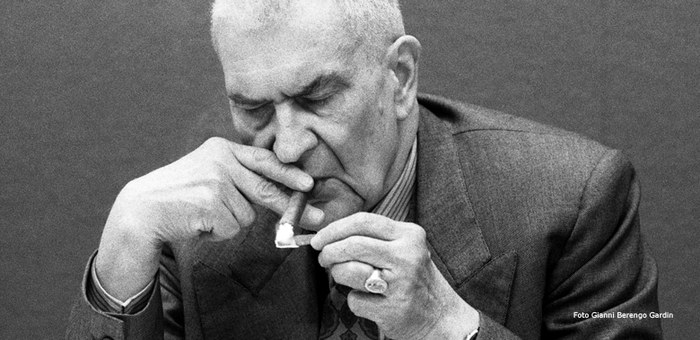Shortly before my mother's passing in 1959, I had purchased an estate of 10 hectares at Mentana on the outskirts of Rome. At the time the area was quiet and rather isolated, and my home was to be built there. Four years later I hired the Roman architect Andrea Busiri Vici to design the project for me. Busiri Vici had planned out a very simple building (which I simplified still further): it would surround a small courtyard meant to hold my collections of inscriptions and ancient fragments, eventually to be known as one of the most important private collections of its kind, second only to Cardinal Alessandro Albani's from the 1700s.
This is how Federico Zeri described his home, where he loved to have his portrait taken with his collection of epigraphs set in the background, a collection of which he was immensely proud, a resounding testimony to his passion for the ancient world.
Objects and paintings from diverse periods and cultures decorated the courtyard, all of which were compiled according to his own personal taste.
The Zeri collection included paintings, sculptures and antiques (mosaics from Antioch, Fayyum portraits, sculptures from Palmyra, Roman marbles), which he was to leave to his heirs and to some major museums: the Vatican, the Académie de France in Rome, Milan's Museo Poldi Pezzoli, the Bergamo Accademia Carrara.
Over the years books and texts that were originally destined for library rooms had taken up every space inside the Villa. His photograph collection also grew, covering the walls and shelves of his office where, at his porphyry table, Zeri would continue to conduct research until his last days.
The library and art photo archive which he donated to Bologna University are housed at the Federico Zeri Foundation. The furnishings of the villa and the scholar's artwork collection were left to the heirs and to important museums.
The epigraphs collection
One sizable nucleus of the antiques collection is made up of nearly 400 epigraphs set into the walls lining the Villa Zeri garden. Along with the villa itself, the art library and photo archive, they form the Bologna University bequest.
Most of them are in Latin and were bought at antiques market. The collection is so rich, wide-ranging and unique, it could provide a comprehensive epigraph manual in its own right.
Zeri's lapidary was published by Guido Barbieri and Maria Grazia Granino Cecere (Zeri's Lapidary of Mentana, 1982, vol.2, and New Acquisitions in Zeri's Lapidary of Mentana, 1988 Istituto Italiano di Storia Antica).
